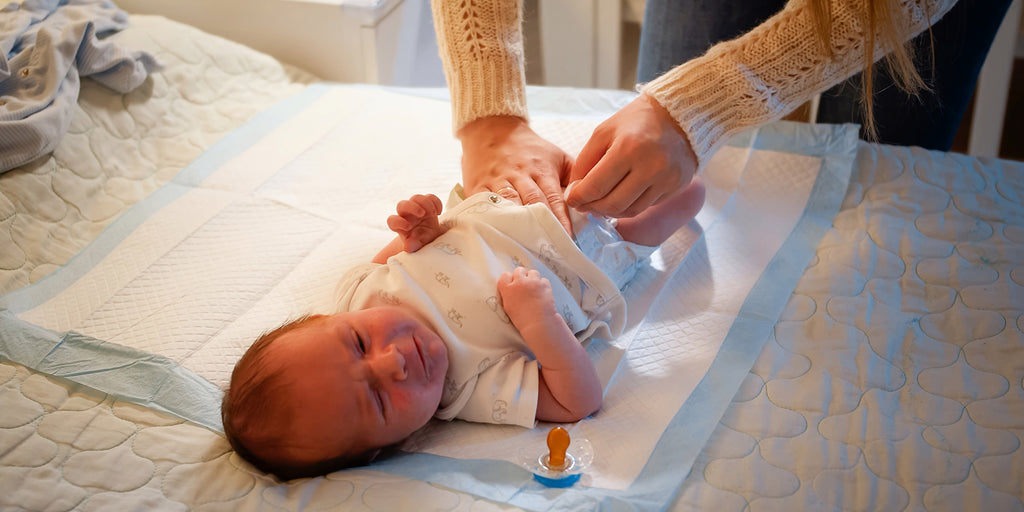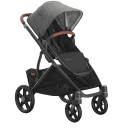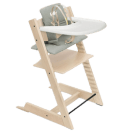
Ah, the joys of parenting—watching your little one sleep peacefully, experiencing their first laugh, and . . . dealing with overnight diaper leaks. Yes, we’ve all been there, changing soggy pajamas and sheets at an ungodly hour, leaving you and your baby feeling less than refreshed come morning. But there is a better way, weary parents. Here’s how to keep your little one comfortable and dry until morning so everyone can catch those much-needed ZZZs.
Last Call Diaper Change
Timing is everything, especially when it comes to that last diaper change before bed. Make it part of your child’s bedtime routine, ensuring it’s the very last step before saying goodnight. So brush those teeth, snuggle in for storytime, and then do a final diaper change before tucking your baby in and saying goodnight.
Use Overnight Diapers
Meet your first line of defense: overnight diapers. Unlike their daytime counterparts, overnight diapers are the superheroes of the sleep world, designed to go the distance (we’re talking a full 10-12 hours of dryness). With about 20-25% more absorbency, they’re a bit bulkier but promise a comfortable fit, ensuring your little one stays dry all night long. Experiment with a few brands to find the perfect match for your baby’s needs, and make sure you’re nailing the fit to avoid any leaks.
Position and Fasten Your Diaper Correctly
Spending a few extra moments to position and fasten the last diaper before bedtime properly can make a huge difference in how frequently you have to manage overnight leaks. Here are our best tips for ensuring your little one’s diaper is snug enough:
- Before placing your baby on the diaper, open it up and give it a good stretch. This stretching action helps ensure your baby is positioned squarely in the center, and it also ensures that all the leg ruffles, elastics, and built-in barriers are properly exposed and not folded inward, allowing them to do their job effectively.
- Position your baby on their back, ensuring the diaper’s fold is just below their bottom. This placement guarantees a snug fit around their legs.
- The back of the diaper should be about halfway up your baby’s back, level with their belly button.
- Lift the diaper’s front up and over your baby, making adjustments where necessary. If it appears the front is sitting too low, the diaper is likely placed too high on your baby’s back. Gently tug it forward to ensure the front is positioned just below the navel, aligning evenly with the diaper’s back. If you have a boy, angle his penis down before pulling up the front of the diaper.
- Fasten the tabs around the waist to ensure the diaper is snug but comfortable—you should be able to easily run your fingers under the waist. If your kiddo is more string bean than meatball, you might need to attach the tabs lower on the front to create a tighter seal around their thighs.
- Run your fingers around the leg cuffs, making sure the frills and elastic borders are pulled out.
Size Up
If you’re battling overnight diaper leaks, ignore the diaper sizing guidelines and opt for one size larger than your baby’s day diapers. So, if your toddler is in a size three in regular diapers, try a size four in overnight diapers. It’s a simple—and somewhat counterintuitive—trick that can make a big difference.
Double Up with a Booster Pad
Even with the best overnight diapers, leaks can still happen. Diaper booster pads add an extra layer of absorbency that might just save your nights. These non-adhesive, universal fit pads fit right inside your baby’s diaper, doubling the absorbency and keeping liquids contained until morning. Play around with positioning to find the perfect setup for your little one. Pro parenting tip: Booster pads should be more forward, towards the front of the diaper for boys, and more center and back of the diaper for girls.
Switch Diaper Brands
Babies, like all humans, come in every shape and size, and not every diaper brand fits every baby perfectly. Diaper brand loyalty can run deep among parents, with many advocating fervently for their favorites. But what works wonders for one child may not suit another. Sometimes, the best approach is to ignore the endless diaper reviews and test out a few brands with your baby to find the best solution to overnight leaks.
Watch the Liquid Intake
Managing liquid intake in the evening for toddlers and little kids can be a game-changer. For toddlers who are toilet training or older children still in diapers at night, consider managing their evening fluid intake. Of course, hydration is important, but try to limit drinks right before bed. Encouraging drinking earlier in the evening gives their body time to process liquids before bedtime, reducing the likelihood of overnight leaks.
Overnight Diaper Leaks FAQs
Why do overnight diaper leaks happen?
Overnight diaper leaks can happen for several reasons, often leaving parents and caregivers puzzled and exhausted from the extra laundry and nighttime changes. Understanding these reasons can help find the right solutions to prevent future leaks. Here are some of the most common causes:
- Incorrect Diaper Size. One of the primary reasons for overnight leaks is using a diaper that doesn’t fit properly. A diaper that’s too small may not have enough absorbency to last through the night, while a diaper that’s too large can have gaps where urine can escape.
- Overwhelming Absorbency Limits. Even the most absorbent diaper has its limits. If a child drinks a lot of fluids before bed, they may simply produce more urine than the diaper can hold, leading to leaks.
- Wrong Type of Diaper. Not all diapers are created equal, especially for overnight protection. Regular daytime diapers may not have the absorbency needed for a long night. Overnight diapers are designed specifically for extended use, with extra absorbency layers to keep moisture away from the skin.
- Poor Fit Around the Legs and Waist. If the diaper isn’t secured snugly around the waist and legs, gaps can form, allowing urine to leak out. Ensuring a good fit is everything, especially around the legs, where leaks are most likely to occur.
- Sleeping Position. The position in which a child sleeps can also affect the likelihood of leaks. For example, side and stomach sleepers may be more prone to leaks at the sides or front of the diaper, where the absorbency might not be as robust.
- Diaper Sagging. Over time, a diaper can become saturated and begin to sag, pulling away from the body and creating opportunities for leaks. This is especially true if the diaper is not changed immediately before bedtime.
- Exceeding the Diaper’s Duration Limit. Most overnight diapers are designed to last 10-12 hours. Leaks are more likely to happen if a child is in bed longer than the diaper’s effective duration.
Are overnight diapers really more effective than regular diapers?
Yes, overnight diapers are generally more effective than regular diapers, making them a preferred choice for parents and caregivers looking to keep their little ones dry through the night. Overnight diapers are more absorbent, are designed for extended wear, and have features like double leak guards that help keep little ones drier overnight than regular diapers.
How can you protect your bedding and mattress from diaper leaks?
Guarding your bedding and mattress against diaper leaks is essential for maintaining a clean and hygienic sleep space for your kiddo. Waterproof mattress pads are designed to fit under the fitted sheet and create a barrier preventing liquids from soaking through the mattress. Many are breathable and come in materials that don’t make noise or feel uncomfortable under the sheets (we’ve come a long way, baby!). You can also try sheet layering: Place a waterproof mattress protector on the mattress, followed by a fitted sheet, then a waterproof pad, and another fitted sheet on top. If a leak occurs, you can quickly remove the top layer of the sheet and waterproof pad, revealing a clean layer underneath, making middle-of-the-night changes faster and easier.
Could overnight leaks be a sign of a health issue?
While occasional overnight leaks are often just a sign of a diaper not fitting correctly or reaching its absorbency limit, frequent or excessive leaking can sometimes indicate a health issue, especially if it’s a new or escalating problem. Conditions such as urinary tract infections (UTIs), diabetes, or even constipation can increase urine production or urgency, resulting in nighttime wetting. Additionally, a sudden onset of bedwetting in a previously toilet-trained child could also signal an underlying stress or emotional issue. Parents need to monitor these occurrences and discuss them with a pediatrician if they persist or are accompanied by other symptoms like fever, pain, excessive thirst, or changes in urine color or odor. A healthcare provider can conduct a thorough evaluation to rule out any medical concerns and provide guidance on managing or treating the condition.
How do you manage overnight diaper leaks during travel or sleepovers?
Managing overnight diaper leaks during travel or sleepovers requires a little preparation and flexibility to ensure your child remains comfortable and dry. Start by packing extra absorbent overnight diapers, or consider double diapering, where you place a regular diaper inside an overnight one for added protection. Bringing disposable bed mats can be a lifesaver; they’re easy to use and discard, offering a quick solution for protecting any sleeping surface. Remember to pack plenty of changes of clothes and extra bedding if possible. Also, maintain your child’s usual bedtime routine as much as possible, including limiting fluid intake before bed to avoid overfilling the diaper. For sleepovers, communicate with the hosting parents about your child’s needs; they may be able to provide additional waterproof bedding or accommodate a late-night diaper change. Lastly, consider a portable waterproof mattress protector or extra large absorbent pads that can be placed under your child wherever they sleep, offering peace of mind and ease of cleanup in unfamiliar environments.
Overnight diaper leaks don’t have to be a staple of parenthood. These simple but effective hacks ensure your baby stays dry, comfortable, and happy throughout the night. It’s all about creating the perfect conditions for a leak-free night, from choosing the right diaper size to adding a booster pad and managing bedtime routines. And remember, every baby is different, so feel free to experiment until you find what works best for your little one. Here’s to dry nights ahead and reclaiming those precious hours of sleep for you and your baby!
Finding What’s Right for You
Albee Baby is the oldest family-owned specialty baby shop in the US, and we pride ourselves on providing our customers with the best assortment of baby products anywhere, at fair prices, always. We’re committed to being an inclusive resource for parents and hope you feel empowered to find the right baby gear for your family. Still have questions? Feel free to contact our baby gear experts at 877.692.5233 or info@albeebaby.com
 Car Seat Sale
Car Seat Sale
 Stroller Sale
Stroller Sale
 Home Sale
Home Sale
 Feeding Sale
Feeding Sale
 Activity & Entertainment Sale
Activity & Entertainment Sale
 Bath & Potty Sale
Bath & Potty Sale






 Car Seats
>
Car Seats
>
 Strollers
>
Strollers
>
 Cribs
Cribs
 High Chairs
High Chairs
 Baby Carriers
Baby Carriers
 Travel Cribs & Playards
Travel Cribs & Playards
 Wagons
Wagons
 Home
>
Home
>
 Bath & Potty
>
Bath & Potty
>
 Diaper Bags & Backpacks
Diaper Bags & Backpacks
 Toys
>
Toys
>
 Gifts
>
Gifts
>
 Clothing
>
Clothing
>

















 Infant Car Seats
Infant Car Seats
 Convertible Car Seats
Convertible Car Seats
 All-in-One Car Seats
All-in-One Car Seats
 Booster Car Seats
>
Booster Car Seats
>
 Travel Systems
Travel Systems
 Car Seat Accessories
Car Seat Accessories
 Single Strollers
Single Strollers
 Double Strollers
Double Strollers
 Single-to-Double Strollers
Single-to-Double Strollers
 Lightweight & Compact Strollers
Lightweight & Compact Strollers
 Jogging Strollers
Jogging Strollers
 Bicycle Trailers & Child Seats
Bicycle Trailers & Child Seats
 Stroller Accessories
Stroller Accessories
 Stroller Frames
Stroller Frames



































